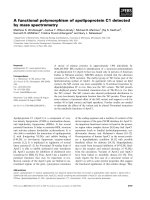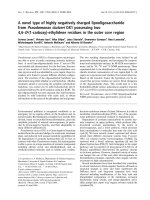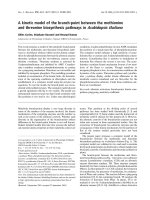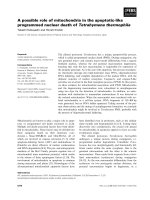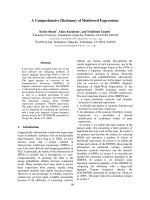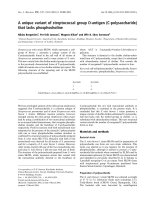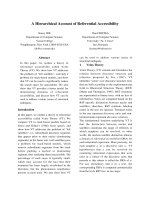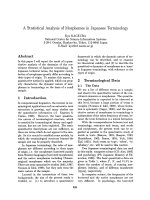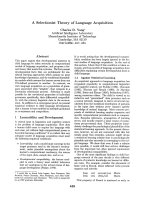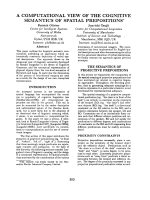báo cáo khoa học: " A quasi-experimental test of an intervention to increase the use of thiazide-based treatment regimens for people with hypertension" docx
Bạn đang xem bản rút gọn của tài liệu. Xem và tải ngay bản đầy đủ của tài liệu tại đây (1.36 MB, 13 trang )
BioMed Central
Page 1 of 13
(page number not for citation purposes)
Implementation Science
Open Access
Research article
A quasi-experimental test of an intervention to increase the use of
thiazide-based treatment regimens for people with hypertension
Carol M Ashton*
1,2,3,4
, MyrnaMKhan
2,3
, Michael L Johnson
2,3
,
Annette Walder
2
, Elizabeth Stanberry
5
, Rebecca J Beyth
1,2,3,4
,
Tracie C Collins
1,2,3,4
, Howard S Gordon
1,2,3,4
, Paul Haidet
1,2,3,4
,
Barbara Kimmel
2
, Anna Kolpakchi
1,4
, Lee B Lu
1,4
, Aanand D Naik
1,2,3,4
,
Laura A Petersen
1,2,3,4
, Hardeep Singh
1,2,3,4
and Nelda P Wray
1,2,3,4
Address:
1
General Medicine Section, Veterans Affairs Medical Center, Houston, Texas, USA,
2
Center for Quality of Care and Utilization Studies,
Veterans Affairs Medical Center, Houston, Texas, USA,
3
Section of Health Services Research, Department of Medicine, Baylor College of Medicine,
Houston, Texas, USA,
4
Section of General Medicine, Department of Medicine, Baylor College of Medicine, Houston, Texas, USA and
5
Pharmacy,
Veterans Affairs Medical Center, Houston, Texas, USA
Email: Carol M Ashton* - ; Myrna M Khan - ; Michael L Johnson - ;
Annette Walder - ; Elizabeth Stanberry - ; Rebecca J Beyth - ;
Tracie C Collins - ; Howard S Gordon - ; Paul Haidet - ;
Barbara Kimmel - ; Anna Kolpakchi - ; Lee B Lu - ;
Aanand D Naik - ; Laura A Petersen - ; Hardeep Singh - ;
Nelda P Wray -
* Corresponding author
Abstract
Background: Despite recent high-quality evidence for their cost-effectiveness, thiazides are underused for controlling
hypertension. The goal of this study was to design and test a practice-based intervention aimed at increasing the use of
thiazide-based antihypertensive regimens.
Methods: This quasi-experimental study was carried out in general medicine ambulatory practices of a large,
academically-affiliated Veterans Affairs hospital. The intervention group consisted of the practitioners (13 staff and 215
trainees), nurses, and patients (3,502) of the teaching practice; non-randomized concurrent controls were the
practitioners (31 providers) and patients (18,292) of the non-teaching practices. Design of the implementation
intervention was based on Rogers' Diffusion of Innovations model. Over 10.5 months, intervention teams met weekly or
biweekly and developed and disseminated informational materials among themselves and to trainees, patients, and
administrators. These teams also reviewed summary electronic-medical-record data on thiazide use and blood pressure
(BP) goal attainment. Outcome measures were the proportion of hypertensive patients prescribed a thiazide-based
regimen, and the proportion of hypertensive patients attaining BP goals regardless of regimen. Thirty-three months of
time-series data were available; statistical process control charts, change point analyses, and before-after analyses were
used to estimate the intervention's effects.
Results: Baseline use of thiazides and rates of BP control were higher in the intervention group than controls. During
the intervention, thiazide use and BP control increased in both groups, but changes occurred earlier in the intervention
group, and primary change points were observed only in the intervention group. Overall, the pre-post intervention
difference in proportion of patients prescribed thiazides was greater in intervention patients (0.091 vs. 0.058; p = 0.0092),
as was the proportion achieving BP goals (0.092 vs. 0.044; p = 0.0005). At the end of the implementation period, 41.4%
of intervention patients were prescribed thiazides vs. 30.6% of controls (p < 0.001); 51.6% of intervention patients had
achieved BP goals vs. 44.3% of controls (p < 0.001).
Published: 13 February 2007
Implementation Science 2007, 2:5 doi:10.1186/1748-5908-2-5
Received: 2 May 2006
Accepted: 13 February 2007
This article is available from: />© 2007 Ashton et al; licensee BioMed Central Ltd.
This is an Open Access article distributed under the terms of the Creative Commons Attribution License ( />),
which permits unrestricted use, distribution, and reproduction in any medium, provided the original work is properly cited.
Implementation Science 2007, 2:5 />Page 2 of 13
(page number not for citation purposes)
Conclusion: This multi-faceted intervention appears to have resulted in modest improvements in thiazide prescribing
and BP control. The study also demonstrates the value of electronic medical records for implementation research, how
Rogers' model can be used to design and launch an implementation strategy, and how all members of a clinical
microsystem can be involved in an implementation effort.
Background
Hypertension affects half to two-thirds of people older
than age 60, and is a major etiologic factor of the leading
causes of mortality and morbidity in developed countries
[1-3]. Control rates, while improving, are abysmally low
[4]. Physicians have a large array of antihypertensive
agents from which to choose. These agents vary less in effi-
cacy than they do in cost, a major concern to payers every-
where.
The Antihypertensive and Lipid-Lowering Treatment to
Prevent Heart Attack Trial (ALLHAT) was an eight-year,
$102 million study funded by the U.S. National Heart,
Lung, and Blood Institute (NHLBI) [5]. ALLHAT is the
largest randomized trial ever conducted to examine the
effects of antihypertensive drugs on clinical outcomes. It
included 33,357 participants older than age 55 (47%
women, 36% diabetic, 35% black) from 623 North Amer-
ican centers, including 7,067 participants from Veterans
Affairs medical centers [6]. ALLHAT showed that thiazide-
based antihypertensive regimens are more cost-effective
than other regimens, a finding that has been incorporated
into current U.S. national hypertension treatment guide-
lines [7]. The main results of ALLHAT were published on
December 18, 2002 to great attention in the medical and
lay press [5]. Despite ALLHAT's high-quality evidence,
national treatment guidelines incorporating its findings,
and extensive press, implementation of ALLHAT findings
into routine clinical practice has been insubstantial, judg-
ing by the low proportion of hypertensive patients on thi-
azides (e.g., <13% in a large US health maintenance
organization [8]), though some increase in anti-hyperten-
sive diuretic use is occurring [8,9]. On February 1, 2006
the NHLBI announced a three-year, $3.7 million effort to
drive ALLHAT results into practice [10], an acknowledge-
ment that ALLHAT's results were having less impact on
practice than was hoped.
The U.S. Veterans Health Administration (VHA) is a feder-
ally funded comprehensive national health care system
that provided services to more than 4.5 million veterans
in 2004. About 95% of VA health care users are men, and
51% are older than age 65. The prevalence of chronic con-
ditions is high; for example, 52% of VA beneficiaries in
the southeastern U.S. have hypertension and 16% have
diabetes [11]. Because of the high prevalence of hyperten-
sion in VA beneficiaries and the relatively low rates of thi-
azide use [12,13], full-scale implementation of thiazide-
based antihypertensive regimens as the treatment of
choice could significantly improve health outcomes and
save considerable costs to our medical center and the VA
system. For example, at the VA medical center (VAMC) in
Houston, Texas the cost of a 90-day supply of hydrochlo-
rothiazide at 25 mg daily is $0.63, while the cost for a 90-
day supply of amlodipine at 2.5 mg daily (one of the
drugs tested in ALLHAT) is $63.54.
The goal of our study was to design and test a strategy to
implement the results of ALLHAT into routine daily prac-
tice, and to add to the emerging body of knowledge on
implementation processes, barriers and facilitators. A six-
month, $50,000 implementation planning grant from the
VA Health Services Research and Development Service
(HSR&D) funded the study. A priori, we specified that to
be classified as effective, our implementation intervention
would have to first, increase the proportion of "eligible"
hypertensive patients (those without indications for non-
thiazide agents as first-line antihypertensive drugs, specif-
ically those with a serum creatinine <2 mg/dL and no
diagnosis of gout or heart failure, the same as specified in
ALLHAT), who were prescribed a thiazide-based regimen,
and second, increase the proportion of hypertensive
patients, regardless of regimen, whose blood pressure was
at goal (<140/90; if diabetic, <130/80) at their most
recent visit to any clinic at the VA medical center [7,14].
Although thiazides have been recommended for hyper-
tension for decades, we viewed ALLHAT's major finding
(that thiazides are the treatment of choice for most
patients with hypertension) as an innovation. Therefore,
the conceptual framework we used to design our strategy
to speed the diffusion of this innovation was Everett Rog-
ers' diffusion model [15]. Rogers' model defines diffusion
as the process by which an innovation is communicated
through certain channels over time, and posits five
attributes of an innovation that drive its rate of adoption:
relative advantage, compatibility (e.g., with organiza-
tional culture), complexity, trialability (ability to try
something out before investing fully), and observability
(being able to see the results).
Methods
Setting, participants, and data sources
This study was approved by the Institutional Review
Board of Baylor College of Medicine and the Research and
Development Committee of the VA Medical Center, Hou-
Implementation Science 2007, 2:5 />Page 3 of 13
(page number not for citation purposes)
ston, Texas. The VAMC in Houston, Texas was the setting
for this project. The staff physicians and nurses of the Gen-
eral Medicine Section (GMS) initiated and conducted the
study. The GMS staff physicians are board-certified in
internal medicine. All provide direct patient care and pre-
cept trainees in hospital and clinic settings; one-half also
conduct health services research. At the time of the study,
the GMS ambulatory practice was a teaching service that
included approximately 150 trainee physicians in post-
graduate years one to three during any academic year, staff
assistants, and roughly 6,000 adult patients. Target panel
sizes ranged from 25 patients for interns, 50 for residents,
and 100–250 for staff physicians. During the intervention
period, which spanned parts of two academic years, 228
unique providers had GMS panels. The GMS and its
patients constituted the intervention group. Because the
GMS designed the intervention and then instituted it
within its own practice, the GMS was the observee, as well
as the observer in this study.
The VAMC's non-teaching adult ambulatory general inter-
nal medicine service (called "PrimeCare") and its roughly
40,000 patients constituted the concurrent control group.
PrimeCare physicians, many of whom are board-certified
internists, spend the majority of their time delivering
direct care and had no outpatient teaching responsibilities
during the study. Target panel sizes ranged from 1000–
1600 patients. During the intervention period, PrimeCare
had 31 practitioners credentialed as independent provid-
ers (24 physicians, 5 physician assistants, and 2 nurse
practitioners).
Upon enrollment at the Houston VAMC, an administrator
assigned each new patient to a GMS or PrimeCare practi-
tioner's panel on a space-available basis. Each practitioner
was responsible for providing assigned patients with con-
tinuous and comprehensive primary care. In addition to
referring for the usual subspecialty consultations, primary
care practitioners could supplement the care of compli-
cated patients by enrolling them in nurse follow-up clin-
ics. Standardized treatment protocols for hypertension
were not in use during the study. VA medical records were
fully electronic, integrated, and accessible to providers.
The medical center's warehouse of computerized medical
record data served as the source of data for identifying
patients with the diagnosis of hypertension, excluding
those with possible indications for non-thiazide first-line
agents (serum creatinine >2 mg/dL, diagnoses of gout
and/or heart failure), and for measuring time trends in the
two outcome measures. We developed computer algo-
rithms for defining the target population and measuring
key variables [11]. We used all patients who met the con-
ditions in our defining algorithms, and did not perform
any sample size or power calculations beforehand. The
target population consisted of patients who had: a) inpa-
tient or outpatient International Classification of Dis-
eases, Ninth Revision, Clinical Modification codes for
hypertension, or b) pharmacy fill records for one or more
anti-hypertensive drugs, or, c) in the absence of either of
the former, at least two elevated blood pressure measure-
ments. The misclassification rate of these algorithms has
not been empirically assessed. The medical center's ana-
lyst used our algorithms on the electronic records in the
data warehouse. Using these data, our study statisticians
conducted all statistical analyses.
Description of the implementation intervention
The implementation plan was team-based. GMS members
were assigned to four teams established to pursue goals
derived from the Rogers diffusion model (Table 1). At
weekly or biweekly steering committee meetings, each
team presented its progress and draft products to obtain
feedback and advice. This iterative process ensured that
each team benefited from the collective expertise of the
GMS and that all GMS members were kept informed. To
overcome complexity, team developed tangible products
(message and vehicles) that would make it easy for a cli-
nician to prescribe thiazides (e.g., pocket cards displaying
treatment algorithms for starting or converting to a thi-
azide). To show relative advantage and influence the
change, team developed pocket cards showing compara-
tive drug costs, informational posters, lectures, literature
repositories about ALLHAT, and electronic reminders in
patient charts. To meet needs for trialability and observabil-
ity, the group analyzed patterns of prescribing and blood
pressure goal attainment in GMS vs. PrimeCare. To expe-
dite communication about the innovation, team members
served as messengers about ALLHAT with patients, inter-
nal medicine trainees, and key medical center entities
(Pharmacy and Therapeutics Committee, medical center
leadership, director of Pharmacy Service, and physician-
directors of non-GMS primary care clinics). We did not
explicitly address compatibility, because cost-effective
care is a cultural cornerstone in the publicly-funded VA
medical care system. The GMS devoted 2,131 person-
hours to the study during the 10.5-month intervention
period.
Because most GMS and PrimeCare practitioners worked
in adjacent clinic halls and had regular contact, we recog-
nized the probability that some elements of the interven-
tion would "leak" into PrimeCare. During the 10.5-
month intervention period, we made no effort to include
or to exclude non-GMS practitioners from the interven-
tion, and we shared materials (e.g., pocket cards) when-
ever asked. After our intervention period ended, we
learned that a contemporaneous quality-improvement
project aimed at increased thiazide prescriptions was
occurring in PrimeCare, consisting of distribution of cop-
Implementation Science 2007, 2:5 />Page 4 of 13
(page number not for citation purposes)
ies of the ALLHAT main results publication, several lec-
tures on ALLHAT's findings, and the introduction of an
electronic reminder to consider a thiazide diuretic into the
medical record of every patient whose blood pressure was
not controlled at the time of the visit and was not pre-
scribed a diuretic. Thus, the PrimeCare comparison group
cannot be considered as a no-treatment control group.
Analysis periods
We present time series data for thiazide use and blood
pressure control in the intervention and control groups
from July 2002 through March 2005 (33 months). The
active intervention period was November 13, 2003
through September 30, 2004. The July 2002–November
2003 pre-intervention period established the baseline and
allowed us to determine whether the December 2002
publication of ALLHAT's main results exerted any effect.
The October 2004–March 2005 post-intervention period
allowed an examination of sustainability of effects.
Statistical analysis
We used statistical process control tools [16] to examine
trends in thiazide use and BP control. In this analysis the
unit of observation was the clinic visit. Because the data
were discrete (the proportion of patients prescribed thi-
azides or achieving BP goals), we used p-type control
charts, calculating control limits of +/- 3 standard errors
based on the pre-intervention period. In such charts, sig-
nificant change is indicated when the mean proportion
rises (or falls) outside the upper or lower control limits.
Using 3 × SE is equivalent to testing using a type 1 error
probability alpha = 0.0027, an adequate correction for
multiple comparisons.
We also analyzed cumulative sum charts, which can detect
subtle changes in time series data missed by control
charts, using "Change-Point Analyzer" software [17]. The
CUSUM (change point) program uses serial bootstrap
sampling of cumulative sums to detect deviations from
the range of expected values. When a change is detected, a
bootstrap analysis is performed to determine a confidence
level for the change and an estimate of when it occurred.
A level 1 or primary change represents the first change
detected. Any other changes are detected by subsequent
passes through the data. We used only level 1 changes to
control for multiple testing. The unit of observation for
the CUSUM analyses was the clinic visit. Key events that
could have inflected the time series lines for thiazide pre-
scribing and BP goal attainment during the observation
period are given in Table 2.
The third method we used to analyze the data ignored its
time series nature, and used the patient as the unit of anal-
ysis in a "before and after" analysis. Using z-tests of pro-
Table 1: List of project teams and their charges
Team Name Charge Attribute from Rogers Model
Steering Committee Create project timeline and milestones; monitor progress; review
and vote on algorithms for starting or switching to thiazides
prepared by Clinician Liaison Team; keep project on track; review
GMS and PrimeCare data on thiazide use and blood pressure goal
attainment
None
Clinician Liaison Team Using published literature (specifically the JNC7 national guidelines)
create algorithms guiding clinicians on how to start or to switch a
patient to thiazides. Review and present literature on effectiveness of
"academic detailing" to change physician behavior.
Complexity
Patient and Administrator Liaison Team Provide informational materials to patients and answer their
questions; conduct focus groups of patients to determine how they
would feel about the use of thiazides, or about changing their
antihypertensive regimens to switch to a thiazide. Inform key VA
medical center leaders about the project and serve as their point of
contact.
Complexity
Communication Team Using information provided by the Clinician Liaison Team and
Steering Committee, format and produce all written materials
concerning the project, including treatment-algorithm and drug-cost
comparison pocket cards for clinicians, exam room posters and
brochures for patients, conference room posters and brochures for
clinicians, blood pressure measurement procedure for nurses, and
project reports
Relative advantage
Performance Analysis Team Devise conceptual and measurement models for tracking patient
outcomes; and oversee computer programming algorithms to use
with the medical center's data warehouse for the prevalence of
hypertension, use of thiazides and other anti-hypertensives, and
blood pressure goal attainment. Assess and establish data quality.
Review and format GMS and PC data on study outcomes.
Observability; trialability
Implementation Science 2007, 2:5 />Page 5 of 13
(page number not for citation purposes)
portions (2-tailed), we compared data on unique patients
seen during the quarter before the intervention started
(July-September 2003) with data on unique patients seen
a year later, during the final months of the intervention
(July-September 2004). Clustering effects are unlikely in
GMS panels: the significant number of trainees and their
rotation schedule led to a large number of different pro-
viders, small numbers of patients per panel, and short
exposure of panels to specific physicians. Clustering may
have been present in PrimeCare, and we did not adjust the
pre-post analyses for it. To the extent such clustering was
present, it would have led to a smaller standard error for
the pooled proportions, which would have increased the
value of the test statistic (z score) and lowered its p value.
In the ALLHAT study, diabetics, older patients, and blacks
were less likely to have their BP under control at three
years [18]. In our sample the proportion of black patients
was roughly the same between General Medicine and
PrimeCare, but General Medicine had a significantly
higher proportion of diabetics and patients over age 65.
Consequently, to adjust for potential confounding factors
we performed before-after analyses stratified by the pres-
ence or absence of diabetes by age <65 or ≥ 65 years.
Results
Between July 2002 and September 2004, 41,609 unique
patients were seen one or more times by GMS and Prime-
Care. Of these, 25,047 (60.2%) carried the diagnosis of
hypertension; of these, 3,253 were excluded because they
were possibly ineligible for thiazides (diagnosed with
gout, heart failure, or a serum creatinine >2 mg/dL), leav-
ing 21,794 unique patients. GMS cared for 3,502 (16.1%)
and PrimeCare cared for 18,292 (83.9%). GMS patients
tended to be older and sicker than PrimeCare patients
(Table 3). The proportion of hypertensive patients receiv-
ing a thiazide-based regimen, and the proportion of
hypertensive patients achieving BP goals were greater in
the GMS at baseline and throughout the entire 33-month
observation period (Figures 1 &2). In both GMS and
PrimeCare patients, the proportion achieving BP goals
declined in November-December in all three years, indi-
cating a seasonal effect coinciding with national holidays.
Pre-intervention period: effects on thiazide use of the
December 2002 publication of ALLHAT's main results
Overall, GMS manifested an upward trend in thiazide use
throughout the 33 month period; in PrimeCare, thiazide
use was flat from July 2002 until December 2002, when it
began an upward trend (Figure 1). The increase during the
pre-intervention period was not large enough in either
GMS or PrimeCare to push the proportion of patients on
thiazide-based regimens outside the upper +/-3 SE control
limits (Figures 3 &4). However, change-point analysis
found a level 1 significant change point with >95% confi-
dence for thiazide prescribing in GMS patients in August
2003, corresponding with the first time an ALLHAT
implementation project was discussed at a GM section
meeting (Table 2). At this meeting, section members were
informed that a deputy VA secretary in Washington had
stated that he intended to return any savings achieved by
a switch to thiazide-based antihypertensive regimens to
Table 2: Key events that could have influenced GMS physicians' propensity to use thiazide-based regimens for their hypertensive
patients
Date Event
December 18, 2002 Main results of ALLHAT is published in JAMA, with extensive coverage of the study in lay press.
Early January 2003 GMS Chief observes a pharmaceutical representative give a pre-clinic talk about amlodipine for hypertension to GMS trainee
physicians. Representative's talk is followed by a presentation given by a GMS physician on the ALLHAT trial and the cost-
effectiveness of thiazides for hypertension. After discussing this at a section meeting and concluding that trainees are getting
mixed messages, GMS decides to ban pharmaceutical representatives from the GMC area.
August 23, 2003 During GM Section meeting, chief announces that a deputy secretary of the Department of Veterans Affairs has stated that
he will return any financial saving reaped by increased use of thiazide-based regimens to the VA medical center that
generated them. Section discusses opportunity to gain funds to support a much-needed additional clinician. (This financial
incentive never materialized.)
October 3, 2003 GMS chief circulates a draft to GMS members describing a potential ALLHAT Implementation Project.
October 9, 2003 During GM Section meeting, section decides to go forward with project as delineated in its October 3 draft. Chief
announces possibility that a new "implementation research" funding initiative might be launched by the VA HSR&D in
Washington, DC.
October 22, 2003 VA HSR&D issues call for implementation planning-grant proposals, due by November 15, 2003.
November 13, 2003 GMS submits proposal for its ALLHAT Implementation Project to VA HSR&D.
December 17, 2003 GMS notified that it has been awarded a $50,000, six-month grant for its ALLHAT Implementation Project
January 15, 2004 Formal project kickoff meeting with full Steering Committee
June 25, 2004 For the first time group-level data for thiazide use and blood pressure goal attainment in GMS vs. PrimeCare became
available for review. Project steering committee (consisting of entire project team) reviews and discusses data. (Panel level
data were not available during the intervention period.)
September 30, 2004 End of active implementation efforts.
December 9, 2004 Formal close of ALLHAT Implementation Project at a GM Section meeting.
Implementation Science 2007, 2:5 />Page 6 of 13
(page number not for citation purposes)
the medical center that generated them. Section members
discussed this as a potential opportunity to try and gener-
ate funds for a much-needed additional clinician. No level
1 significant change points in thiazide prescribing were
detected in PrimeCare during the pre-intervention period.
Intervention period (13 November 2003–30 September
2004): effects of the implementation intervention
During the intervention period, the proportion of GMS
and PrimeCare patients on thiazides rose outside the
upper limits of their control charts and generally
remained there, indicating significant change (Figures 2
&3). The escape from the upper control limits occurred
three months earlier in GMS than in PrimeCare. No level
1 change points were detected in thiazide prescribing in
GMS or PrimeCare during the intervention period.
During the intervention period, the proportion of GMS
and PrimeCare patients attaining BP goals rose outside
the upper limits of their control charts, indicating signifi-
cant change (Figures 5 &6). The sustained escape from the
upper control limits occurred in March 2004 in GMS and
in May 2004 in PrimeCare. Change-point analysis
detected a level 1 significant change point in GMS patients
in March 2004 – a month during which we "saturated"
trainees by giving them six pre-clinic lectures on ALLHAT,
provided trainees with an ALLHAT reprint collection, and
distributed an ALLHAT brochure to all patients. No level
1 change points in BP control rates were detected in
PrimeCare.
Post-intervention period (October 2004–March 2005)
The improvements in thiazide use and in BP goal attain-
ment appear to have been sustained through the end of
the observation period (Figures 1 though 6) in GMS as
well as PrimeCare.
Before-after analyses
In a comparison of patients seen in July-September 2004
(toward the end of the intervention period) with those
seen during July-September 2003 (before the intervention
began), 41.4% (1,232/2,973) of GMS patients were pre-
scribed a thiazide compared with 30.6% (4,154/13,575)
of PrimeCare patients (Table 4). The pre- and post-inter-
vention difference in proportion of thiazide use was
greater in GMS patients (0.091 vs. 0.058; p = 0.0092).
Similarly, a higher proportion of GMS patients achieved
BP control compared with PrimeCare: 51.6% (1,535/
2,973) versus 44.3% (6,017/13,575), respectively. The
pre- and post-intervention difference in BP control was
greater in GMS patients (0.092 vs. 0.044; p = 0.0005).
The stratified analyses (Table 4) show that in both GMS
and PrimeCare more diabetics than nondiabetics were
Table 3: Characteristics of study patients with hypertension*
General Medicine (Intervention)
(n = 3,502)
PrimeCare (Comparison)
(n = 18,292)
p
Male, n (%) 3424 (97.8) 17824 (97.4) 0.2506
Race & ethnicity, n (%)
Non-Hispanic white 2340 (66.8) 12292 (67.2) <0.0001
Non-Hispanic black 1080 (30.8) 5342 (29.2)
Hispanic 2 (0.1) 180 (1.0)
Other or unknown 80 (2.3) 478 (2.6)
Age, mean(SD) 65.3 (11.4) 63.2 (12.2) <0.0001
Age category, n (%)
<45 years 107 (3.1) 1085 (5.9) <0.0001
45–64 1563 (44.6) 9173 (50.2)
65–74 1015 (29.0) 4288 (23.4)
≥75 817 (23.3) 3746 (20.5)
Coexisting conditions, n (%)
Diabetes 1796 (40.9) 7039 (33.6) <0.0001
Ischemic heart disease 1542 (35.1) 4875 (23.3) <0.0001
Cerebrovascular disease 604 (13.8) 1747 (8.3) <0.0001
Peripheral arterial disease 520 (11.8) 1714 (8.2) <0.0001
*Unique patients seen one or more times by General Medicine or PrimeCare practitioners between July 1, 2002 (start of pre-intervention period)
and September 30, 2004 (end of intervention period). Numbers will not match those in Table 4 because we studied a dynamic cohort during the
33-month observation period, with patients entering as they met inclusion criteria and exiting due to death or departure from the VA health care
system.
Implementation Science 2007, 2:5 />Page 7 of 13
(page number not for citation purposes)
prescribed a thiazide at baseline. Proportions increased
modestly after the intervention, but the magnitude of the
pre- and post-intervention increases in diabetics patients
did not differ significantly between GMS and PrimeCare.
Though diabetics were more likely to be prescribed thi-
azides, they were less likely than non-diabetics to have
their BP under control at baseline, as well as after the
intervention (Table 4). Among diabetics younger than age
65, the percentage of patients at BP control in GMS
increased after the intervention from 30.4% to 39.4%,
and in PrimeCare from 24.3% to 28.6%; the pre- and
post-intervention differences in proportions (0.090 and
0.043, respectively) did not achieve statistical significance
(p = 0.0778). Among diabetics older than age 65, the per-
centage of patients at BP control in GMS increased after
the intervention from 23.6% to 37.3%, and in PrimeCare
from 22.9% to 26.4%; the pre- and post-intervention dif-
ferences in proportions (0.137 and 0.035, respectively)
achieved statistical significance (p = 0.0004).
Discussion
Though the effects of the intervention were small, we con-
clude that our multi-faceted intervention did increase thi-
azide prescribing and BP control rates in GMS. In this
quasi-experimental study, we used three methods (statis-
tical control charts, change-point analysis, and pre-post
analyses) to estimate the effects of the intervention on thi-
azide prescribing and BP control rates in the intervention
group. Thiazide prescribing and BP control rates moved
out of the upper limits of their control charts several
months earlier in GMS than in PrimeCare. Change-point
analyses detected two first-level deviations in GMS (one in
thiazide prescribing and the other in BP control rates) but
none in PrimeCare. Pre-post analyses indicated that the
proportion of patients prescribed thiazides increased by
0.091 in GMS compared with 0.058 in PrimeCare, while
the proportions of patients achieving BP control increased
by 0.092 in GMS and 0.044 in PrimeCare.
The 9.1% increase in persons prescribed thiazides is com-
parable to what was found in a two-by-two factorial rand-
Proportion of hypertensive patients on a thiazide-based regimen, General Medicine vs. PrimeCare, July 2002 through March 2005Figure 1
Proportion of hypertensive patients on a thiazide-based regimen, General Medicine vs. PrimeCare, July 2002 through March
2005.
Implementation Science 2007, 2:5 />Page 8 of 13
(page number not for citation purposes)
omized controlled trial in 200 family practices in British
Columbia [19]. In that study, thiazide prescribing
increased by 11.5% in the practices assigned to receive
personalized feedback on prescribing patterns plus an
educational module. At the end of our intervention
period, more than 40% of GMS patients were prescribed a
thiazide, a much higher proportion than the 10–12%
reported from another large US health care system [8].
Regarding changes in BP goal achievement rates, if we take
the increase in PrimeCare as an indicator of the upward
secular trend, an improvement of 4.4% in BP goal attain-
ment rates would have been expected without our inter-
vention. The intervention group manifested a 9.2%
increase, thus we conclude that our intervention was asso-
ciated with a modest increase in BP goal attainment rates.
Because relatively small reductions in blood pressure
translate into meaningful reductions in the risk of stroke,
heart attack, and heart failure, the results of our interven-
tion, if sustained, will be clinically significant for our
patients [7]. Many interventions aimed at improving
blood pressure control in hypertension have been tested
[20-23]. Their results are variable, but many have found
larger effects than our study. Nevertheless, the 51.6% of
intervention patients who achieved goal blood pressures
in this project approaches the 55.2% achieved at one year
in the ALLHAT [18] – a randomized trial that used a less
stringent goal for diabetics with hypertension. Moreover,
it is substantially better than national survey data for con-
trol at the 140/90 mmHg threshold: 29% of patients in
the U.S., 17% in Canada, and ≤ 10% in Europe [4].
Because this study was performed in a VA setting, almost
all patients were men; however, the proportions of black
patients (29.5%) and patients with diabetes (40.5%) were
roughly similar to ALLHAT's (35% black, 36% diabetic).
Another aspect of this study that deserves note is that it
was performed in a tax-supported public health care set-
ting in which health care cost-containment is explicitly
valued and frequently discussed. Our findings are proba-
bly not generalizable to fee-for-service practice settings.
The effect of our intervention on thiazide use and BP goal
attainment was probably muted because of the improve-
Proportion of hypertensive patients attaining goal blood pressures (<140/90 if nondiabetic; <130/80 if diabetic), General Medi-cine vs. PrimeCare, July 2002 through March 2005Figure 2
Proportion of hypertensive patients attaining goal blood pressures (<140/90 if nondiabetic; <130/80 if diabetic), General Medi-
cine vs. PrimeCare, July 2002 through March 2005.
Implementation Science 2007, 2:5 />Page 9 of 13
(page number not for citation purposes)
Statistical process control chart, thiazide usage, General Medicine, July 2002–March 2005Figure 3
Statistical process control chart, thiazide usage, General Medicine, July 2002–March 2005. Upper and lower con-
trol limits (dashed lines) are ± 3 SE, based on pre-intervention period.
Statistical process control chart, thiazide usage, PrimeCare, July 2002–March 2005Figure 4
Statistical process control chart, thiazide usage, PrimeCare, July 2002–March 2005. Upper and lower control limits
(dashed lines) are ± 3 SE, based on pre-intervention period.
Implementation Science 2007, 2:5 />Page 10 of 13
(page number not for citation purposes)
ments that were occurring in PrimeCare due to their own
quality enhancement projects for thiazide use and hyper-
tension control and, possibly, to contamination from our
project. This points out the importance of not assuming
that practice patterns in a real-world "usual care" compar-
ison groups will be in a steady state – and nor should they
be in a culture of continuous quality improvement. In
addition, the GMS group had a higher percentage of
patients with diabetes (40.9%) compared with PrimeCare
(33.6%), and BP goals for diabetics are more stringent
(130/80). As the stratified analyses show, the implemen-
tation intervention in GMS led to real progress in BP goal
achievement in persons with diabetes. Our experience
attests to the challenges inherent in real-world implemen-
tation projects aimed at improving quality of care, and the
importance of including a comparison group when test-
ing a quality improvement intervention.
Implementation studies must often be conducted under
conditions in which randomized designs are difficult or
impossible to use and contamination is impossible to pre-
vent. Ours was a non-randomized study, and bias may
have affected the results. The fact that GMS patients were
older and more likely to have diabetes than PrimeCare
patients would have made it harder for GMS doctors and
patients to increase thiazide use and achieve BP goals over
the observation period. However, features of practitioners
also were different between the groups, and the extent to
which differences in their behavior explain the consist-
ently higher proportion of GMS patients on thiazides and
meeting blood pressure goals cannot be determined from
this study design. Another limitation of this study is that
we could not assess the influence of any individual ele-
ment of our intervention. To the extent that different ele-
ments of a multi-faceted intervention can be introduced
in sequence, time series data such as we used might help
researchers discern which elements were most powerful
and thereby worthy of retention. This small study focused
on designing a multi-faceted intervention and putting it to
its initial test. In fact, it is important to note that we devel-
Statistical process control chart, blood pressure goal attainment, General Medicine, July 2002–March 2005Figure 5
Statistical process control chart, blood pressure goal attainment, General Medicine, July 2002–March 2005.
Upper and lower control limits (dashed lines) are ± 3 SE, based on pre-intervention period.
Implementation Science 2007, 2:5 />Page 11 of 13
(page number not for citation purposes)
oped the intervention during the study rather than before
we began. In a real sense, developing the intervention was
the intervention itself. Testing the influence of any partic-
ular aspect of the intervention will require a larger study
with a stronger design.
Conclusion
Our study adds to the empirical and theoretical base of
implementation science in several ways. First, it demon-
strates the enormous value of electronic medical record
systems for interventions aimed at improving practice.
Electronic medical records made it possible for us to study
nearly 22,000 unique patients with a modest grant of
$50,000. Second, it shows the value and the limitations of
Rogers' model for the diffusion of innovations, when that
model is used in a clinical setting. Because physicians
must prescribe thiazides and patients must agree to use
them, our intervention focused on communicating the
ALLHAT's major findings to them, and ensuring they
found it acceptable and easy to use them in practice. The
Rogers model proved helpful in structuring the elements,
processes, and products of our intervention. However, it
was not helpful when we faced trying to "institutionalize"
the elements of our implementation intervention into the
daily GMS practice without the benefit of external
research funding. At that point our efforts should have
been guided by a model of organizational change rather
than a model for the diffusion of innovations. Using Rog-
ers' model to guide the development and launch of the
implementation plan and then shifting to a model of
organizational change to guide activities directed at sus-
taining beneficial change would have been a more effec-
tive approach. Third, our study illustrates how all front-
line members of a practice – patients, doctors, nurses, and
other professionals – can be engaged and can contribute
meaningfully in efforts to implement high-quality
research evidence into clinical practice, corroborating the
Institute of Medicine's assertion that practice improve-
ment happens within such microcosms of care, or hap-
pens not at all [24].
Statistical process control chart, blood pressure goal attainment, PrimeCare, July 2002–March 2005Figure 6
Statistical process control chart, blood pressure goal attainment, PrimeCare, July 2002–March 2005. Upper and
lower control limits (dashed lines) are ± 3 SE, based on pre-intervention period.
Implementation Science 2007, 2:5 />Page 12 of 13
(page number not for citation purposes)
Table 4: Before-after analyses* of number and percentages of patients prescribed a thiazide prescribing and patients achieving BP
goals regardless of medication regimen, overall and stratified by diabetes status and age older or younger than 65 years.
General Medicine (Intervention) PrimeCare (Comparison) p
PRESCRIBED A THIAZIDE, n(%)
All Patients
Before intervention 845/2616 (32.3) 3103/12510 (24.8)
After intervention 1232/2973 (41.4) 4154/13575 (30.6)
Pre-post difference in proportions 0.091 0.058 0.0092
Among Diabetics < 65
Before intervention 159/464 (34.3) 523/2209 (23.7)
After intervention 203/500 (40.6) 794/2581 (30.8)
Pre-post difference in proportions 0.063 0.071 0.5939
Among Diabetics
≥
65
Before intervention 209/543 (38.5) 522/1897 (27.5)
After intervention 260/600 (43.3) 581/1877 (31.0)
Pre-post difference in proportions 0.048 0.035 0.3451
Among Non-Diabetics < 65
Before intervention 203/687 (29.5) 1041/4449 (23.4)
After intervention 351/888 (39.5) 1611/5405 (29.8)
Pre-post difference in proportions 0.100 0.064 0.0790
Among Non-Diabetics
≥
65
Before intervention 274/922 (29.7) 1017/3955 (25.7)
After intervention 418/985 (42.4) 1168/3712 (31.5)
Pre-post difference in proportions 0.127 0.058 0.0021
AT BLOOD PRESSURE CONTROL, n(%)
All Patients
Before intervention 1108/2616 (42.4) 4992/12510 (39.9)
After intervention 1535/2973 (51.6) 6017/13575 (44.3)
Pre-post difference in proportions 0.092 0.044 0.0005
Among Diabetics < 65
Before intervention 141/464 (30.4) 537/2209 (24.3)
After intervention 197/500 (39.4) 738/2581 (28.6)
Pre-post difference in proportions 0.090 0.043 0.0778
Among Diabetics
≥
65
Before intervention 128/543 (23.6) 435/1897 (22.9)
After intervention 224/600 (37.3) 496/1877 (26.4)
Pre-post difference in proportions 0.137 0.035 0.0004
Among Non-Diabetics < 65
Before intervention 341/687 (49.6) 2146/4449 (48.2)
After intervention 531/888 (59.8) 2846/5405 (52.6)
Pre-post difference in proportions 0.102 0.044 0.0265
Among Non-Diabetics
≥
65
Before intervention 498/922 (54.0) 1874/3955 (47.4)
After intervention 583/985 (59.2) 1937/3712 (52.2)
Pre-post difference in proportions 0.052 0.048 0.4374
* The active intervention began 14 November 2003 and ended 30 September 2004. "Before intervention" denotes unique patients seen during the
90-day period from 1 July through 30 September 2003. "After intervention" denotes unique patients seen during the final 90 days of the active
intervention, from 1 July through 30 September 2004.
Implementation Science 2007, 2:5 />Page 13 of 13
(page number not for citation purposes)
Competing interests
Michael Johnson and Nelda Wray received grant funding
for an unrelated study from Pfizer, Inc.; neither feel that
this influenced them in the conduct of our ALLHAT
implementation study. None of the other authors has a
competing financial interest that could have influenced
their interpretation of the results of this study.
Authors' contributions
CMA designed the project, obtained funding, led the
project team, and drafted the manuscript. MJK and MLJ
planned and conducted all statistical analyses, and AW
did the statistical programming. All the authors served as
members or leaders of one or more of the implementation
teams, helping to design and produce the elements of the
implementation intervention and bring those elements
into use. All the authors worked together to coordinate
the project as members of the Steering Committee. All the
authors reviewed the data and helped to interpret the
findings. All authors read and approved the final manu-
script.
Acknowledgements
This research was supported by a $50,000 "Innovations to Implement Evi-
dence-Based Clinical Practice" grant from the VA Health Services Research
and Development Service in Washington, DC and by resources provided
by the VA Medical Center in Houston. All the authors were employees of
the Veterans Health Administration of the US Department of Veterans
Affairs at the time the study was conducted. The funders of the project had
no influence over the design or conduct of the study and had no influence
over the study findings or their interpretation. The views expressed in this
paper are not necessarily those of the Veterans Health Administration.
The authors of this paper gratefully acknowledge the significant contribu-
tions of the other members of the Houston Veterans Affairs Medical
Center ALLHAT Implementation Group because the project could not
have been done without them: Vanessa Brown, Jeffery T. Bates, Carmen R.
Brown, Gus Camacho del Rio, Ruth M. Collins-Smith, Julia de la Houssaye,
Belinda F. Hadnot, Adonna Peacock, Althea Phillips-Edwards, LeChauncy
Woodard, and Louis Wu.
References
1. Primatesta P, Brookes M, Poulter NR: Improved hypertension
management and control. Results from the Health Survey
for England 1998. Hypertension 2001, 38:827-32.
2. Lloyd-Jones DM, Evans JC, Levy D: Hypertension in adults across
the age spectrum. Current outcomes and control in the
community. JAMA 2005, 294:466-72.
3. Murray CJL, Lopez AD: Global mortality, disability, and the
contribution of risk factors: Global Burden of Disease Study.
Lancet 1997, 349:1436-42.
4. Wolf-Maier K, Cooper RS, Kramer H, Banegas JR, Giampaoli S, Joffres
MR, Poulter NPrimatesta P, Stegmayr B, Thamm M: Hypertension
treatment and control in five European countries, Canada,
and the United States. Hypertension 2004, 43:10-7.
5. The ALLHAT officers and coordinators for the ALLHAT Collabora-
tive Research Group: Major outcomes in high-risk hypertensive
patients randomized to angiotensin-converting enzyme
inhibitor or calcium channel blocker vs. diuretic. JAMA 2002,
288:2981-97.
6. Wright JT, Cushman WC, Davis BR, Barzilay J, Colon P, Egan D,
Lucente T, Nwachuku C, Pressel S, Leenen FHH, Frolkis J, Letterer R,
Walsh S, Tobin JN, Deger GE, for the ALLHAT Research Group: The
Antihypertensive and Lipid-Lowering Treatment to Prevent
Heart Attack Trial (ALLHAT): clinical center recruitment
experience. Controlled Clin Trials 2001, 22:659-673.
7. Chobanian AV, Bakris GL, Black HR, Cushman WC, Green LA, Izzo
JL, Jones DW, Materson BJ, Oparil S, Wright JT Jr, Roccella EJ: The
seventh report of the Joint National Committee on preven-
tion, detection, evaluation, and treatment of high blood
pressure (JNC 7 report). JAMA 2003, 289:2560-72.
8. Pettiti DB, Xie F, Barzilay JI: Prescribing patterns for thiazide
diuretics in a large health maintenance organization: rela-
tionship to participation as an ALLHAT clinical center. Con-
temp Clin Trials 2006, 27:397-403.
9. 2004 Drug Trend Report. :13. (MEDCO monograph http://
www.drugtrend.com)
10. [ />].
11. Johnson ML, Pietz K, Battleman DS, Beyth RJ: Prevalence of
comorbid hypertension and associated cardiovascular dis-
ease. Am J Managed Care 2004, 10:926-32.
12. Lopez J, Meier J, Cunningham F, Siegel D: Antihypertensive medi-
cation use in the Department of Veterans Affairs: a national
analysis of prescribing patterns from 2000 to 2002. Am J
Hypertension 2004, 17:1095-9.
13. Singh H, Johnson ML: Prescribing patterns of diuretics in multi-
drug anti-hypertensive regimens. J Clin Hypertension 2005,
7:81-7.
14. Alexander M, Tekawa I, Hunkeler E, Fireman B, Rowell R, Selby JV,
Massie BM, Cooper W: Evaluating hypertension control in a
managed care setting. Arch Intern Med 1999, 159:2673-77.
15. Rogers , Everett : Diffusion of innovations. 4th edition. New York:
The Free Press; 1995.
16. Carey RG: How do you know that your care is improving? Part
II: using control charts to learn from your data. J Amb Care
Management 2002, 25:78-88.
17. Taylor WA: Software Change-point Analyzer 2.0. [http://
www.variation.com].
18. Cushman WC, Ford CE, Cutler JA, Margolis KL, Davis BR, Grimm
RH, Black HR, Hamilton BP, Holland J, Nwachuku C, Papademetriou
V, Probstfield J, Wright JT, Alderman MH, Weiss RJ, Piller L, Betten-
court J, Walsh SM, for the ALLHAT Collaborative Research Group:
Success and predictors of blood pressure control in diverse
North American settings: The Antihypertensive and Lipid-
Lowering Treatment to Prevent Heart Attack Trial (ALL-
HAT). J Clin Hypertens 2002, 4:393-404.
19. Herbert CP, Wright JM, Maclure M, Wakefield J, Dormuth C, Brett-
MacLean P, Legare J, Premi J: Better Prescribing Project: a rand-
omized controlled trial of the impact of case-based educa-
tional modules and personal prescribing feedback on
prescribing for hypertension in primary care. Family Practice
2004, 21:575-81.
20. Fahey T, Schroeder K, Ebrahim S: Interventions used to improve
control of blood pressure in patients with hypertension.
Cochrane Database of Systematic Reviews 2006:CD005182. DOI:
10.1002/14651858. CD005182.pub2.
21. Walsh JME, McDonald KM, Shojania KG, Sundaram V, Nayak S, Lewis
R, Owens DK, Goldstein MK: Quality improvement strategies
for hypertension management. A systematic review. Med
Care 2006, 44:646-657.
22. Boulware LE, Daumit GL, Frick KD, Minkovitz CS, Lawrence RS,
Powe NR: An evidence-based review of patient-centered
behavioral interventions for hypertension. Am J Prev Med 2001,
21:221-232.
23. Chodosh J, Morton SC, Mojica W, Maglione M, Suttorp MJ, Hilton L,
Rhodes S, Shekelle P: Meta-analysis: chronic disease self-man-
agement programs for older adults. Ann Intern Med 2005,
143:427-438.
24. Committee on Quality Health Care in America, Institute of Medicine:
Crossing the quality chasm: a new system for the 21
st
cen-
tury. Washington DC; National Academy Press; 2001:11-144.
